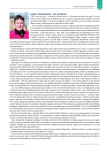Remnant cholesterol: a fact or fiction?
Reflection on the problems related to remnant cholesterol
Authors:
Vladimír Soška 1,2
Authors‘ workplace:
Oddělení klinické biochemie FN U sv. Anny v Brně
1; II. interní klinika, Katedra laboratorních metod, LF MU, Brno
2
Published in:
AtheroRev 2017; 2(2): 118-121
Category:
reviews
Overview
Remnant cholesterol is cholesterol content in residual triglyceride-rich particles, which are both remnant of chylomicrons and remnant of VLDL (very low density lipoproteins) – IDL (intermedial density lipoproteins). Unfortunately the term remnant cholesterol is now often used for cholesterol content in very low density lipoproteins – VLDL, which are not remnant particles, as they are synthesized in hepatocytes. This results in confusion and misunderstanding not only what remnant cholesterol is, but also how can we measure or calculate it and what is its relationship to cardiovascular diseases.
Key words:
cholesterol, remnant cholesterol, triglycerides, VLDL
Sources
1. Nordestgaard BG, Varbo A. Triglycerides and cardiovascular disease. Lancet 2014; 384(9943): 626–635. Dostupné z DOI: <http://dx.doi.org/10.1016/S0140–6736(14)61177–6>.
2. Varbo A, Benn M, Nordestgaard BG. Remnant cholesterol as a cause of ischemic heart disease: evidence, definition, measurement, atherogenicity, high risk patients, and present and future treatment. Pharmacol Ther 2014; 141(3): 358–367. Dostupné z DOI: <http://dx.doi.org/10.1016/j.pharmthera.2013.11.008>.
3. Nordestgaard BG, Langsted A, Mora S et al. Fasting is not routinely required for determination of a lipid profile: clinical and laboratory implications including flagging at desirable concentration cut-points-a joint consensus statement from the European Atherosclerosis Society and European Federation of Clinical Chemistry and Laboratory Medicine. Eur Heart J 2016; 37(25): 1944–1958. Dostupné z DOI: <http://dx.doi.org/10.1093/eurheartj/ehw152>.
4. Masuda D, Yamashita S. Postprandial Hyperlipidemia and Remnant Lipoproteins. J Atheroscler Thromb 2017; 24(2): 95–109. Dostupné z DOI: <http://dx.doi.org/10.5551/jat.RV16003>.
5. Taguchi M, Ishigami M, Nishida M et al. Remnant lipoprotein-cholesterol is a predictive biomarker for large artery atherosclerosis in apparently healthy women: usefulness as a parameter for annual health examinations. Ann Clin Biochem 2011; 48(Pt 4): 332–337. Dostupné z DOI: <http://dx.doi.org/10.1258/acb.2011.010244>.
6. Nguyen SV, Nakamura T, Uematsu M et al. Remnant lipoproteinemia predicts cardiovascular events in patients with type 2 diabetes and chronic kidney disease. J Cardiol 2017; 69(3): 529–535. Dostupné z DOI: <http://dx.doi.org/10.1016/j.jjcc.2016.04.011>.
7. Varbo A, Benn M, Tybjaerg-Hansen A et al. Remnant cholesterol as a causal risk factor for ischemic heart disease. J Am Coll Cardiol 2013; 61(4): 427–436. Dostupné z DOI: <http://dx.doi.org/10.1016/j.jacc.2012.08.1026>.
8. Langsted A, Freiberg JJ, Nordestgaard BG. Fasting and nonfasting lipid levels: influence of normal food intake on lipids, lipoproteins, apolipoproteins, and cardiovascular risk prediction. Circulation 2008; 118(20): 2047–2056. Dostupné z DOI: <http://doi: 10.1161/CIRCULATIONAHA.108.804146>.
9. Yoshida H, Kurosawa H, Hirowatari Y et al. Characteristic comparison of triglyceride-rich remnant lipoprotein measurement between a new homogenous assay (RemL-C) and a conventional immunoseparation method (RLP-C). Lipids Health Dis 2008; 7: 18. Dostupné z DOI: <http://dx.doi.org/10.1186/1476–511X-7–18>.
10. Kurosawa H, Doumitu K, Kobayashi M et al. [Relevance of lipoprotein cholesterol levels measured by HPLC method to appearance midband on electrophoresis and remnant-like particle (RLP)-cholesterol levels]. Rinsho Byori 2004; 52(9): 737–741.
11. Friedewald WT, Levy RI, Fredrickson DS. Estimation of the concentration of low-density lipoprotein cholesterol in plasma, without use of the preparative ultracentrifuge. Clin Chem 1972; 18(6): 499–502.
12. Nakamura T, Takano H, Umetani K et al. Remnant lipoproteinemia is a risk factor for endothelial vasomotor dysfunction and coronary artery disease in metabolic syndrome. Atherosclerosis 2005; 181(2): 321–327.
13. Jepsen AM, Langsted A, Varbo A et al. Increased Remnant Cholesterol Explains Part of Residual Risk of All-Cause Mortality in 5414 Patients with Ischemic Heart Disease. Clin Chem 2016; 62(4): 593–604. Dostupné z DOI: <http://dx.doi.org/10.1373/clinchem.2015.253757>.
14. Nakamura T, Hirano M, Kitta Y et al. A comparison of the efficacy of combined ezetimibe and statin therapy with doubling of statin dose in patients with remnant lipoproteinemia on previous statin therapy. J Cardiol 2012; 60((1): 12–17. Dostupné z DOI: <http://dx.doi.org/10.1016/j.jjcc.2012.02.005>.
15. Chan DC, Watts GF, Barrett PH et al. Effect of atorvastatin on chylomicron remnant metabolism in visceral obesity: a study employing a new stable isotope breath test. J Lipid Res 2002; 43(5): 706–712.
16. Westphal S, Wiens L, Guttler K et al. Chylomicron remnants of various sizes are lowered more effectively by fenofibrate than by atorvastatin in patients with combined hyperlipidemia. Atherosclerosis 2003; 171(2): 369–377.
17. Ooi TC, Cousins M, Ooi DS et al. Effect of fibrates on postprandial remnant-like particles in patients with combined hyperlipidemia. Atherosclerosis 2004; 172(2): 375–382.
18. Westphal S, Orth M, Ambrosch A et al. Postprandial chylomicrons and VLDLs in severe hypertriacylglycerolemia are lowered more effectively than are chylomicron remnants after treatment with n-3 fatty acids. Am J Clin Nutr 2000; 71(4): 914–920.
Labels
Angiology Diabetology Internal medicine Cardiology General practitioner for adultsArticle was published in
Athero Review

2017 Issue 2
Most read in this issue
- What is the role of nutriceuticals in dyslipidemia management? Armolipid Plus
- Combination treatment with antihypertensive and hypolipidemic drugs
-
Remnant cholesterol: a fact or fiction?
Reflection on the problems related to remnant cholesterol - Changes in the lipid spectrum in endocrinopathies
